|
|
| RHP |
South African
River Health Programme
|
State of the Rivers Report
uMngeni River and Neighbouring Rivers and Streams
|
PIETERMARITZBURG RESOURCE UNIT
|
|
This resource unit is dominated by the urban sprawl of Pietermaritzburg (altitude 750m), a mix of formal city, residential and industrial suburbs and informal housing developments. Here the uMsunduze River enters a canalised reach (an 'artificial' river) at Camps Drift. It then passes through the city in an incised narrow channel and is joined by small tributaries before picking up treated effluent from Darvill wastewater works. Large parts of Pietermaritzburg used to be floodplains and wetlands but the river system is now a shadow of what it was. The total population of the area is 239 500 people.
|
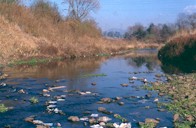
|
Water quality in the region is Poor mainly due to faecal contamination and declines as the river passes through the city. Interestingly, the effluent from Darvill Wastewater Works often improves the quality of the river water.
Of concern is the Poor health of both the instream and riparian habitats. Extensive canalization (particularly at Camps Drift) has significant impacts on the river's natural flow pattern. Because of Poor water quality (eutrophic and turbid water) habitat is Poor for the natural fauna and flora.
The decline in the health of the invertebrates from Good to Poor over a few kilometres, shows the magnitude of urban impacts. In the lower reaches of the city, only the toughest invertebrates survive, and then in great quantities due to the abundance of organic "food" (i.e. pollutants).
Fish health is Good, as most of the indigenous species in the area are resilient to pollution. However, alien species abound, especially in the Camps Drift impoundment, where carp and bass are common. The weirs on the river are mostly impassable to migrating fish.
|
|
Urbanization and high population densities, including areas with minimal sanitation services. The extensive network of sewers discharges its contents into the river at times.
City street storm water discharges can be as polluting as sewage discharges. The large surface area of paved ground and rooftops increases run-off during storm events.
Legal and illegal discharges from factories are a major problem, particularly on the Baynspruit tributary, which drains the Willowton Industrial area.
Impoundment of the river at Camps Drift has extensively altered its nature.
Mowing of riparian vegetation and canalization reduces the river's ability to recover from flooding, increases flow velocities and results in damage to river morphology within and downstream of the resource unit.
Large alien trees (e.g. at Alexandra Park) and other invasive alien plants in the riparian zone shade natural vegetation, destabilise the banks and alter the instream habitat.
|
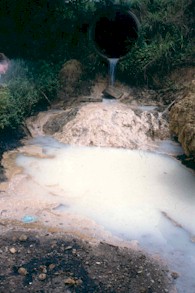
|
Transport and assimilation of domestic and industrial pollutants.
Informal domestic water use especially from the small tributaries entering the uMsunduze.
Recreational and subsistence fishing.
Adequate river flow and sufficient water of adequate quality to support contact recreation like canoeing (e.g. Dusi canoe marathon); threatened at times due to poor water quality. Swimming is no longer safe here.
The river forms the focal point of an open space outdoor and parkland facility - Alexandra Park and Camps Drift. The full potential of this facility is spoiled by poor water quality.
River-based educational activities are widespread.
|
|
Reduction in pollution from sewers, informal settlements, city streets, illegal discharges and the wastewater works and reduction in solid waste (litter).
Control of water weeds and alien weeds in the riparian zone, including removal of large alien trees, unless where serving an important function (e.g. shading in Alexandra Park).
|
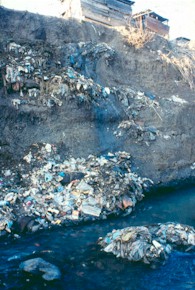
|
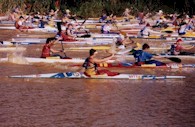
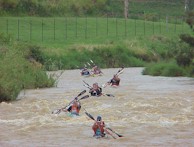
|
In January each year, the Dusi canoe marathon starts at Camps Drift in Pietermaritzburg and ends at Blue Lagoon in Durban, with some 3000 paddlers participating. The total exchange of money on this event in direct costs i.e. equipment and accommodation, is R20 - 30 million. The marketing value is approximately R100 million, giving an indication of the economic value of a sporting event which relies heavily on adequate river flow and good water quality. The Dusi marathon has redirected much of its income to developments in the rural parts of the catchment.
Unfortunately the event is threatened by faecal contamination and by water hyacinth choking the river near the estuary.
|
| DRAGONFLIES AND RIPARIAN VEGETATION
|
|
|
Dragonflies are familiar to us as the pretty aerial creatures associated with streams and ponds. Young dragonflies (larvae) live underwater in the weed or mud and are highly sensitive to stream conditions such as flow, water temperature and amount of sunlight on the water.
|
|
Most species avoid heavily forested areas, except where there is dappled sunlight on the bank and water. Invasive alien plants in the riparian zone over-shade the banks, making the habitat unsuitable for most dragonfly species. Local biologists recently found that the removal of invasive alien plants has a dramatically positive effect on dragonfly abundance. Within one season of alien plant removal, dragonflies return. Dragonfly abundance and diversity can thus provide an indication of both instream and riparian vegetation health.
|
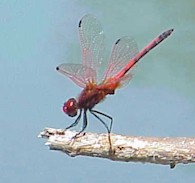
|
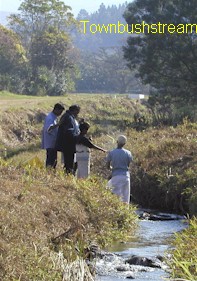
|
Several local communities make use of the rivers for cultural and religious purposes (Hindu ceremony on the Townbushstream.)
Dragonflies are also sensitive to altitude. The species found at Albert Falls are quite different from those at Midmar. Pietermaritzburg lies in between and has dragonfly species from both higher and lower elevations. This dual recruitment combined with a variety of habitats makes the National Botanical Gardens at Pietermaritzburg a dragonfly hotspot of 30 or so species.
|
|